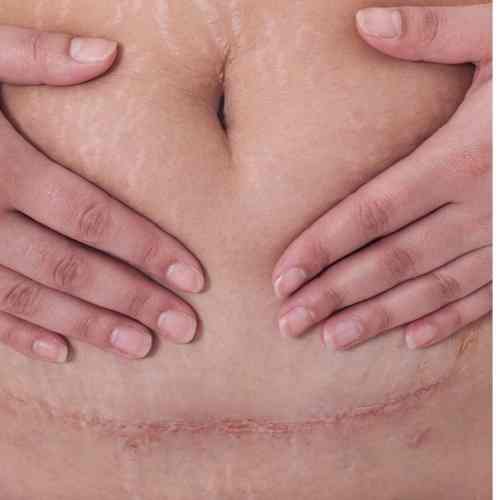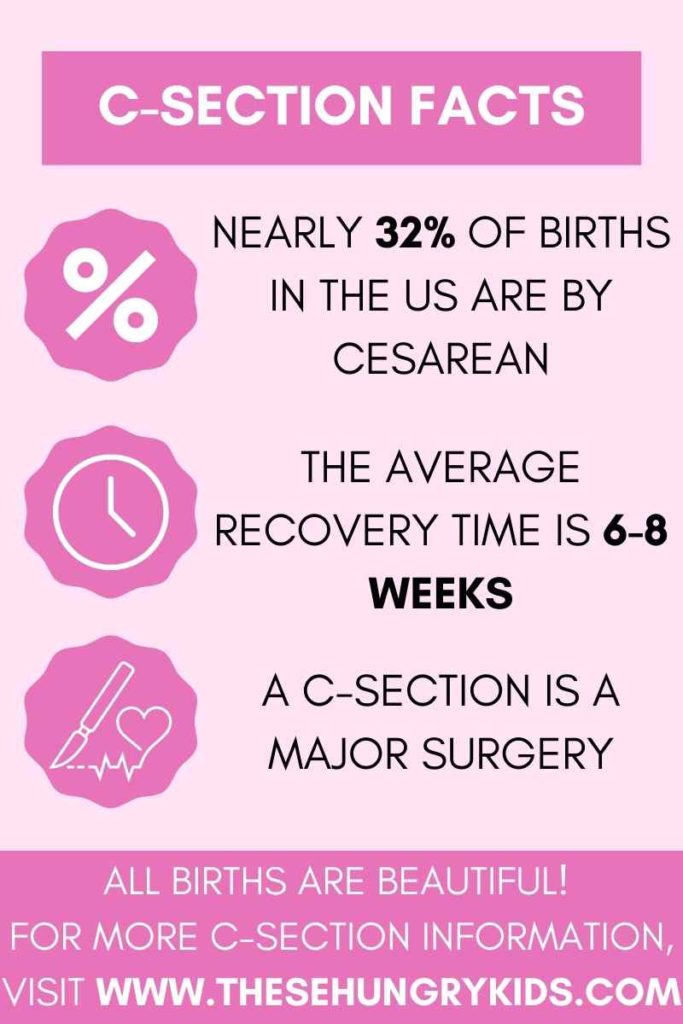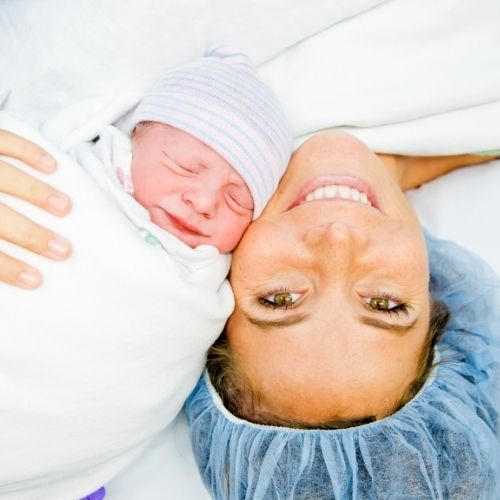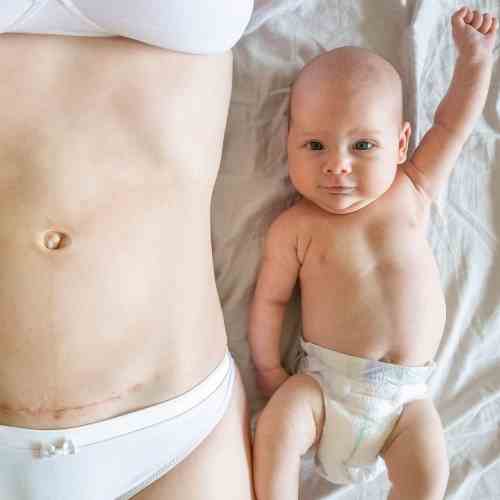These c-section facts may surprise you! Learn if you will feel pain during your c-section, how long c-sections take, and about the anesthesia used.
When it comes time to have your baby, there are two ways to give birth: vaginally or by c-section.
C-section is the shortened way to say cesarean section, or delivering the baby surgically through an incision in the abdomen. Typically, the incision for a c-section is very low, at the top of the bikini line.
For some, the idea of a c-section sounds fantastic! For others, it’s a scary procedure they’d like to leave off the birth plan. No matter how you deliver, your baby’s birth is beautiful and worth celebrating.
As a labor and delivery nurse, I’ve been involved in many c-sections. And I know first hand some of the things that shock and surprise the parents-to-be.
These facts about c-sections may surprise you! Cesarean birth is beautiful and very common, so it’s a smart idea to understand them. Maybe some of these c section facts will shock you!

DISCLAIMER: My mission is to prepare and inform, not advise. There is no place for shame or guilt in labor – you are entitled to give birth however you see fit. Pain meds, no pain meds, vaginal or c-section, you rock it, mama!! The information in this post is purely for entertainment and is not meant to replace the advice of a medical professional. I always adhere to HIPPAA policies, any similarities to yours or anyone else’s story is purely coincidental. Please see my disclosure policy for more information.
Surprising c-section facts
1. You should not feel pain, but you will feel tugging and pressure.
Your surgeon should make sure you are good and numb before cutting, and they do a few different tests to make sure you can’t feel anything sharp or prickly!
Most c-sections are done using a spinal anesthetic. If you’re panicking because you’ve had an epidural before that didn’t work, don’t fret! Spinal blocks are similar, but they are different.
With an epidural, a catheter is placed into the epidural space of your spine to give you a continuous drip of medication to keep you numb. If you have an epidural for your labor that is working well, your anesthesiologist may give you a different dose of medication to get you numb for a c-section if that’s the course your labor has taken.

With a spinal block, there are no needles or catheters left in your back. The medication is placed into the fluid around the spinal cord in a one time dose. You will start to feel the numbing effects instantly, unlike an epidural which takes up to 30 minutes to work.
Either way, your anesthesia team will make sure you are numb for your c-section. That means that you won’t feel the cut from the incision, but you will be able to feel them touching and moving your stomach.
The lower half of your body will be completely numb, but you’ll still be able to move your arms and head.
For more info on epidurals, check out these posts
7 Shocking Epidural Myths
Epidurals for Labor: The Facts!
2. C-sections take about 30-45 minutes, though you may spend over an hour in the operating room.
While c-sections are a major surgery, they are quick!
Baby is usually born within 15 minutes of the first incision. After that, it’s just a matter of putting your belly back together!

The rest of the time in the operating room is spent getting your spinal working and getting you prepped and cleaned for surgery.
After the baby is born, the surgeon will sew your uterus and belly back together. They may place a dressing over your c-section incision, depending on your doctor’s preference.
Once the incision is closed and clean, you will be moved to a recovery room where your blood pressure, vital signs, pain levels, and bleeding will be monitored before being moved to your postpartum room.
Skin-to-skin may be possible in the operating room, but is often started when you move to the recovery room.
Related: 9 C-section Recovery Tips to Help You Heal Quickly
3. The incision is very low
The c-section incision is very low, just a few inches above the pubic bone. This is called a low transverse incision, and it’s been shown to be better than an abdominal incision.

This type of incision is often hidden by pubic hair or underwear and is pretty small. It is a horizontal cut, not a vertical incision.
4. You’ll most likely be awake during your c-section, and that’s a good thing!
The benefit of using a spinal anesthetic for your c-section is that you get to be awake!
I know that sounds scary, but remember, all you’ll feel is some pulling and tugging on your belly. And then you get to hear the sweet cry of your little baby!
Occasionally, c-sections are done under general anesthesia. With general anesthesia, you will be asleep. Moms who have general anesthesia tend to wake up in more discomfort after the c-section, and they miss the first hour or so of the baby’s life.
By being awake for the c-section, you still get to hear baby’s first cries, the announcement of the baby’s weight, and get to be one of the first to lay eyes on your newborn!

5. You won’t be getting up to use the bathroom for a while afterwards, so you’ll have a catheter to keep your bladder empty.
It takes a few hours after the spinal to get your leg strength back, so it’s safest to keep your bladder empty with a catheter.
The catheter will come out once you are able to get up and move! It’s typically in for less than 24 hours.
Afterwards, you will still have some vaginal bleeding, just like with a vaginal delivery. Wearing pants and underwear that go above your scar are going to be most comfortable (here are my recommendations!)
Related: 21 Brilliant Snacks For Your Hospital Bag (To Keep Energy High!)
6. Nearly 32% of births in the United States were c-section deliveries in 2018
According to the Centers for Disease Control (CDC), the rate of cesarean delivery in 2018 was 31.9%.
This number really surprised me! But there are many factors that come into play when we look at cesarean birth rate…
For starters, some hospitals and doctors require a c-section for any mom who has had a c-section in the past. This varies greatly from region to region, so if you desire a vaginal birth after you’ve had a c-section, you can find a provider who is willing to work with you for future pregnancies.
Some people choose to have a c-section! There are many reasons someone may choose to have a c-section, and it’s really a personal choice.
You can check with your local hospitals to see their c-section rate if it’s something you’re interested in knowing.

7. There are many medical reasons for a c-section delivery
While you may be looking to avoid a surgical procedure at all costs, sometimes a cesarean delivery is the safest way to have a baby. Certain maternal medical conditions or concerns for baby’s wellbeing may make the surgical delivery of a baby necessary.

Some common reasons for a c-section include:
- Breech presentation: your doctor may recommend a planned c-section if your baby is not head down. This is because there are many potential problems that can be avoided during a breech vaginal delivery.
- Fetal intolerance of labor: your health care team is constantly assessing the fetal heart rate. If baby’s heart rate is dropping too low, or there are signs that the fetus may not tolerate labor much longer, it may be safer to get the baby out than keep them in.
- Cord prolapse: this is when the umbilical cord comes out of the birth canal before the baby’s head! This creates an emergency situation, because the umbilical cord is the baby’s source of oxygen. Though rare, this is cause for an emergency c-section.
- Fatigue: sometimes moms will say they can’t do it anymore, and they desire a c-section. This is most common after days of laboring, or after hours and hours of pushing.
- Labor stalls: in order to have a vaginal birth, the cervix needs to dilate to 10cm. Rarely, the cervix does not dilate despite strong, consistent contractions. This is more common in women who have had surgery on their cervix.
- A very large baby: While having a large baby is not always an indication for a c-section, some kids just won’t fit.
- A baby in an abnormal position: sometimes baby’s head gets stuck! If other interventions, like position changes, have not worked, your doctor may suggest a cesarean birth.
- Infection: any source of infection is stressful to mom and baby! If the infection becomes a big source of stress for mom or baby, a c-section may be recommended.
- Previous c-section: sometimes a repeat c-section is necessary if you’ve had a prior c-section. Your health care provider may be concerned for uterine rupture, which is when the uterus tears. This is more likely to happen with a pregnancy after a cesarean section along the uterine incision from the first c-section.
- Placenta previa: this is when the placenta covers the cervix. Your provider will recommend a scheduled c-section if you have placenta praevia since you will be at a higher risk for blood loss and postpartum hemorrhage.
- Placental abruption: This is when the placenta separates from the uterine wall before delivery. A caesarean section may be needed for baby’s safety.
It’s important to note that these are not all of the reasons a mom might get a c-section. Talk to your healthcare provider to see if you have any risk factors that may require a cesarean delivery.

8. You won’t be able to move your lower body for a few hours.
This is due to the spinal anesthetic, but it’s still a shock to many moms!
It typically takes a few hours after the spinal is administered to be able to move your legs after a cesarean delivery. This may sound scary to you, but it will wear off quicker than you’d think!
Once your sweet baby is bundled in your arms, you’ll forget that you can’t move your legs to begin with.
To prevent blood clots, you will wear stockings that will compress your legs, essentially massaging them. The stockings can come off once you are able to walk around again.

9. Recovery after a c-section is longer than after a vaginal birth
Though you may not be uncomfortable during delivery, typically c-section moms take a bit longer to return to normal activities after baby’s birth.
Let’s not forget that a cesarean section is abdominal surgery, your surgeon had to cut through your abdominal muscles, uterine wall, and your skin to get your baby out!
The recovery period after a c-section is 8 weeks, versus the 6 weeks it typically takes to recover from a vaginal birth. You can also expect to have a longer hospital stay after cesarean deliveries.
In the first few weeks, you may notice some cramping and soreness. A heating pad can be helpful, as can pain medicine. Make sure you have a good support person to help you care for yourself and baby in the first few weeks.
More info on c-section births
-9 Tips For A Fast Recovery From C-Section
-Best Pants and Undies For After A C-Section
-Best Postpartum Nightgowns
-The Scoop On Postpartum Bleeding
Did any of these facts surprise you? If you have a c-section, be gentle with your body as you recover. Here are some great tips for a smooth recovery after a c-section written by a cesarean mama.
Let me know in the comments below! I love hearing from you.


